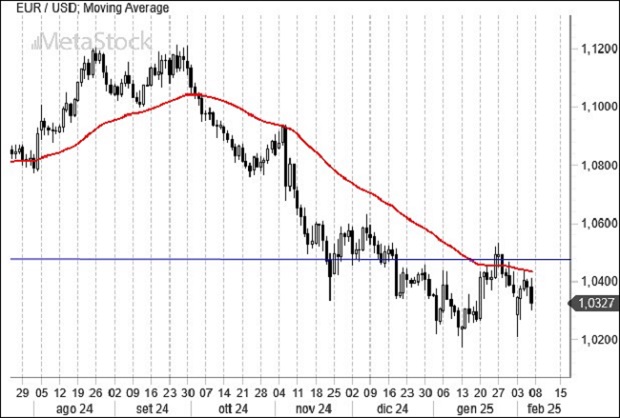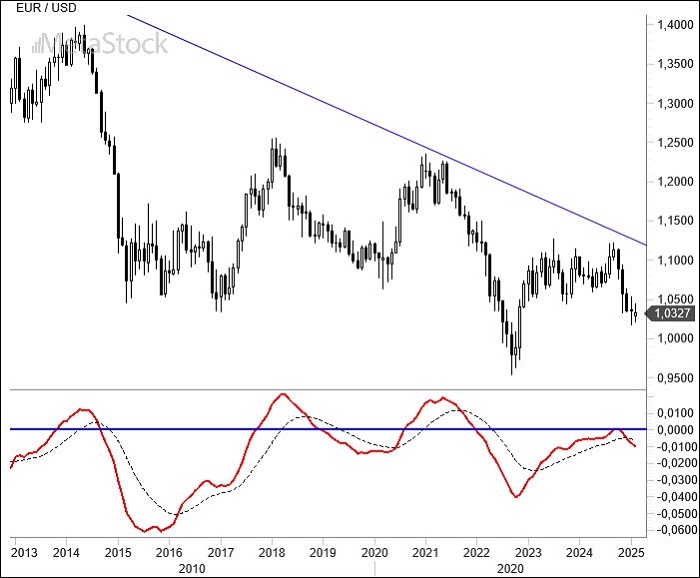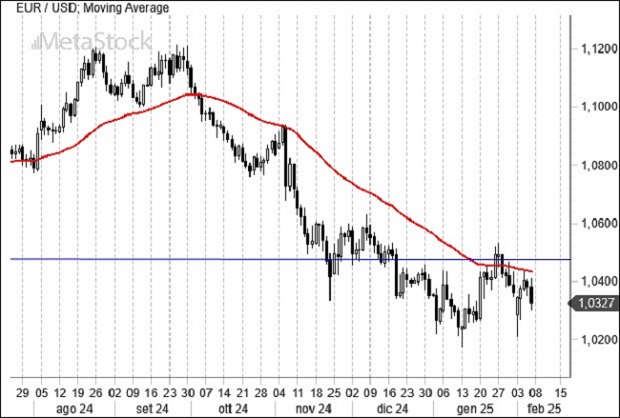The U.S. President takes decisive action by imposing tariffs on Canada, Mexico, and China, but quickly reverses the decision for the first two countries. The desire for negotiations ultimately prevails, yet fears remain regarding potential inflation and new measures targeting other economic regions.
Europe braces for the impact of Trump’s tariffs, with countermeasures in place, while France attempts to pass its budget proposal and Germany enters full-blown election season.
EUR/USD continues to exhibit highly technical behavior, constrained between support levels of 1.02 and resistance at 1.05. For now, the bear market remains dominant.
Tariff Tensions and Global Economic Impact
The tariff war against Mexico and Canada lasted only 24 hours. The initial announcement allowed both countries to open negotiations aimed at strengthening security and border control, with the deployment of thousands of troops along the borders.
As a result, Trump decided to suspend tariffs on both neighboring countries. The tariffs, initially set at 25% on all imports except energy products from Canada, which would face a 10% tariff, were postponed. This decision is now pending until early March when Marco Rubio’s negotiations with the two countries will likely provide further clarity.
Meanwhile, the tariffs on China remain at 10%, with China swiftly retaliating by implementing protectionist measures on coal and natural gas.
In the midst of this, Europe hesitates, trying to pass its budget law in France while preparing for the upcoming German elections, hoping the far-right won’t gain too much ground.
The Federal Reserve is currently standing on the sidelines, but it’s clear that Trump’s announced measures could have significant implications for inflation and the mutual trust between foreign states in funding America’s massive future debt. In these conditions, it’s hard to anticipate a rate cut, especially since the labor market remains strong, with the unemployment rate dropping to 4%.
A rate cut, however, seems inevitable in the Eurozone, where the economy stagnates, and inflation, although no longer decreasing, doesn’t appear to be a major concern for now. The market is pricing in an interest rate between 1.5% and 2% by the end of 2025.
The European Central Bank (ECB) must also carefully consider the euro’s performance, as overly dovish measures could push the currency further down, challenging support levels of 1.02. A weak euro, of course, imports inflation.
Technical Analysis: EUR/USD Support at 1.02 and Resistance at 1.05-1.06
The support at 1.02 has once again proven its strength. This level is the final barrier before a potential drop below parity. Technical analysis textbooks would confirm that the euro’s reaction, despite a challenging day like the Monday following the tariffs announcement, indicates this. At the same time, it’s undeniable that any attempt to push higher will be futile as long as the solid resistance levels at 1.05-1.06 continue to limit the euro’s ambitions. This is the key point where we could see further weakness in the U.S. dollar.

The close of January has confirmed the long-term bearish signals, with the EUR/USD MACD crossing the zero line and reversing direction downward, crossing the signal line from above.
For now, if the euro does rebound, it is unlikely to exceed a simple pullback toward resistance before new lows are reached. A confirmed reversal would only occur above 1.05-1.06.



Leave a Reply
You must be logged in to post a comment.